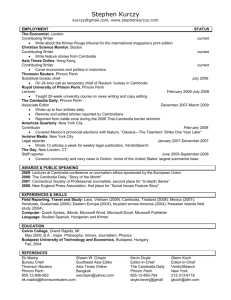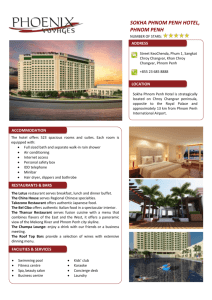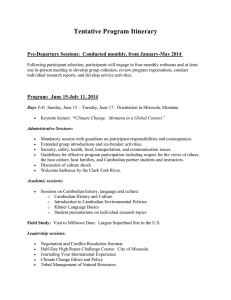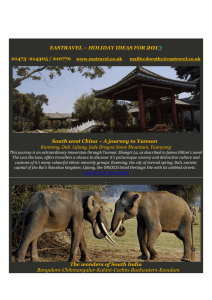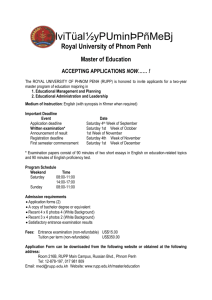David Gunn & Lyno Vuth opportunity to speak at this forum
advertisement
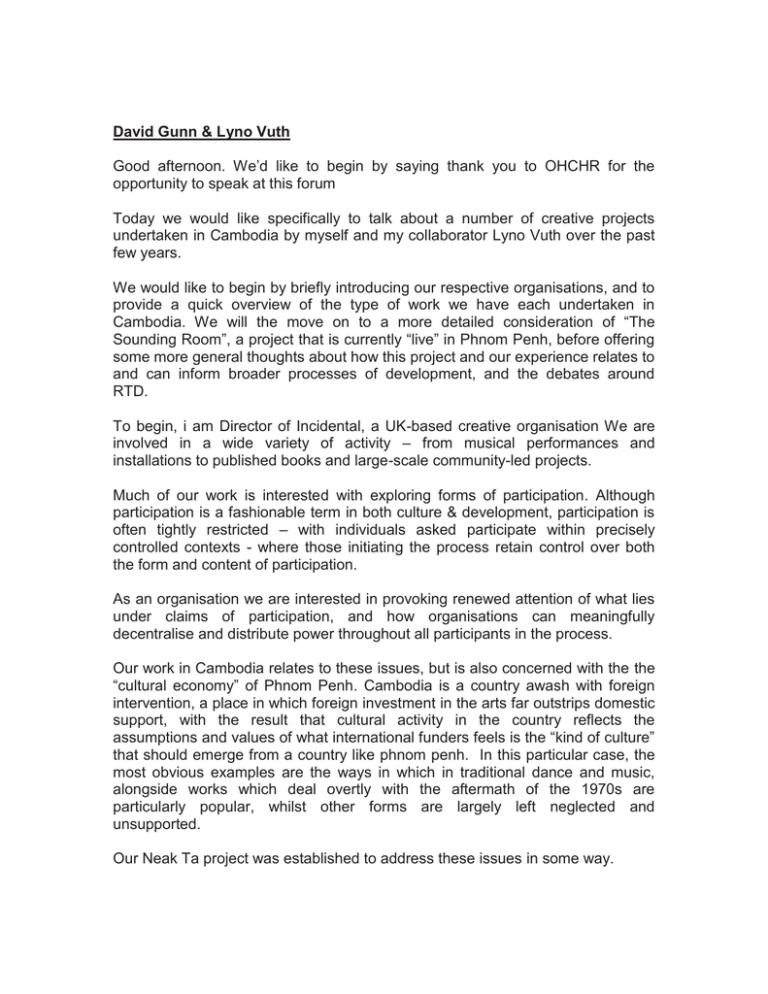
David Gunn & Lyno Vuth Good afternoon. We’d like to begin by saying thank you to OHCHR for the opportunity to speak at this forum Today we would like specifically to talk about a number of creative projects undertaken in Cambodia by myself and my collaborator Lyno Vuth over the past few years. We would like to begin by briefly introducing our respective organisations, and to provide a quick overview of the type of work we have each undertaken in Cambodia. We will the move on to a more detailed consideration of “The Sounding Room”, a project that is currently “live” in Phnom Penh, before offering some more general thoughts about how this project and our experience relates to and can inform broader processes of development, and the debates around RTD. To begin, i am Director of Incidental, a UK-based creative organisation We are involved in a wide variety of activity – from musical performances and installations to published books and large-scale community-led projects. Much of our work is interested with exploring forms of participation. Although participation is a fashionable term in both culture & development, participation is often tightly restricted – with individuals asked participate within precisely controlled contexts - where those initiating the process retain control over both the form and content of participation. As an organisation we are interested in provoking renewed attention of what lies under claims of participation, and how organisations can meaningfully decentralise and distribute power throughout all participants in the process. Our work in Cambodia relates to these issues, but is also concerned with the the “cultural economy” of Phnom Penh. Cambodia is a country awash with foreign intervention, a place in which foreign investment in the arts far outstrips domestic support, with the result that cultural activity in the country reflects the assumptions and values of what international funders feels is the “kind of culture” that should emerge from a country like phnom penh. In this particular case, the most obvious examples are the ways in which in traditional dance and music, alongside works which deal overtly with the aftermath of the 1970s are particularly popular, whilst other forms are largely left neglected and unsupported. Our Neak Ta project was established to address these issues in some way. Working with national institutions such as Cambodian Living Arts and the Royal University of Fine Arts we established a series of open-ended residencies to work with young cambodian musicians and artists, to experiment and explore contemporary and locally relevant forms of culture. The work resulted in the formation of a new musical ensemble called “Krom Monster” which combined experimental and improvisational techniques with traditional khmer music and instruments. We are currently developing this work further to foster peer-learning amongst young musicians across the city. With RUFA, the residencies resulted in a series of collaborative projects design and led by students, using participatory processes to engage a range of Cambodians in reflecting upon processes of urban change in Phnom Penh. *** LYNO: Thank you David. Good afternoon Mr Chairperson, distinguished panelists, delegates, ladies and gentlemen. My name is Lyno Vuth. I am the Director of Sa Sa Art Projects, an initiative founded by a group of Cambodian artists called Stiev Selapak (or Art Rebels). We are a group of multi-disciplinary artists interested in questioning and exploring ideas of national development and “today’s changes” of Cambodia. I would like to begin with a couple of example of the type of work that we do. Firstly, Wrapped Future is a photo series of corrugated metal fences at construction sites that are increasingly becoming a common landscape of the capitol city. Before, there were vibrant communities, public land or water, and traditional homes. Now, concrete structures are rising behind these fences as invisible foreign investors unveiling future vision of the modernized and privatized Phnom Penh. Another of our projects is Thoamada. As discrimination and social stigma are still attached in such a conservative culture, Thoamada uses participatory and collaborative approach to explore the identity of Cambodian gay community and challenges public assumption and stereotypical association. But we are not just about photographic projects. One of our initiatives is Sa Sa Art Projects which aims to offer a “space” for building honest network of artists, curators, scholars, and audiences who are passionate in contributing to the culture and development of Cambodia. We offer diverse formats of knowledge sharing activities ranging from artist talks, artist residencies, skills training and workshops, exchange programs with regional and international artists, and community participation. It is important for me to note that Sa Sa Art Projects is not an NGO. We are an experimental mechanism rather than a fixed, permanent organization. One of the reasons is that we are trying to move away from traditionally operated NGO model, which heavily relies on funds. Of course, we do need money, but by not binding to a rigid organizational model, Sa Sa Art Projects is able to “evolve organically” to adapt to the changing society. Sa Sa Art Projects resides in the iconic White Building at the heart of Phnom Penh city. The White Building was built in the 1960s and was one of most admired examples of affordable urban housing solution. Today, this building hosts a vibrant and diverse low-income urban residents, although carries a reputation as an unsafe neighborhood of irregular activities. Like many structures in Phnom Penh, it seems likely that this building will be demolished in the coming years to make way for high profile development over this desirable stretch of land in central Phnom Penh. We decided to work in The White Building for a few reasons. First of all, we wanted to create high quality works that are easily accessible to and enjoyed by everyday Cambodian people, rather than answering the interests of expats and the international art market. Secondly, we wanted to honor the beautiful and highly efficient Cambodian architecture. And finally, we hoped to challenge some of the existing preconceptions about the Building and find ways to reflect and contribute to a more positive presentation of this neighborhood. I’d now like to move to talking about our “live” project entitled “The Sounding Room” which being worked on now as we speak. The Sounding Room is a collaborative project initiated by Sa Sa Art Projects and Incidental. It is a largescale, interactive sound installation that occupies Sa Sa Art Projects space in the White Building. It consists of a range of instruments inspired by traditional Khmer musical instruments but redesigned and reconstructed using a range of industrial and salvaged materials. This space is co-designed and co-created with a range of local participants, and will result in a flexible space that will host a variety of events. This will include improvised performance events, where audiences will enter the space and be invited to participate in spontaneous, collaborative performances. These performances will be accompanied by a series of open discussions, workshops and talks on a variety of issues over a period of three weeks. During this time the Sounding Room will operate as an open public space, with local residences and the public encouraged to initiate and host their own events. The Sounding Room is in many ways a hybrid project. It is funded by Arts Network Asia and The British Embassy, reflecting its relevance for both artistic field and right-based development. In this way, The Sounding Room seeks to create a hybrid experience that engages Cambodian audiences in both highquality artistic experiences and open, honest discussions about complex and inter-related issues in contemporary Phnom Penh. Now I would like to return the floor to David to elaborate on the values of this project and how it sits under the framework of right to development. Thank you. DAVID: Before moving on to our concluding remarks, I think it is important to note that we are not alone in pursuing this kind of work – around the world there are hundreds of organizations and individuals who are also working on work that should also be celebrated within the context of the Forum. I think it is important to mention here that we are interested in culture AND development, rather than cultural development. I.e. we are not focusing upon forms of cultural conservation or support, but rather the ways in which grass roots, participatory cultural activity, or the arts, can both comment on, enrich and challenge parallel processes of development. Firstly, cultural projects can offer radically open platforms for participation. Much development activity focuses upon “target audiences” or “communities in need”, where individuals are identified, and engaged because of particular features of their socio-economic, ethnic or geographical background. Such processes can be helpful, but also impose fixed identities upon diverse, complex groups. With the creation “strange spaces” such as the Sounding Room, we seek to establish radically open environments, where individuals are encourage to attend as “entire selves” and to shape both the form and content of the work. In this way, cultural projects can work to resist imposed identities, to articulate more complex and multiple senses of belonging, to replace permanent communities of place with ideas of “temporary communities of action” and to surface resistance to established norms of engagement and development. Secondly, cultural projects can foster a renewed engagement with ideas of site. Although we may question concepts of “authentic culture”, the validity of ideas like “british culture” or “cambodian culture”, nonetheless we believe projects should maintain an intimate relationship to the sites and locations in which they occur. In this sense, cultural projects can provoke a renewed attention and examination to the unique characteristics, challenges and resources of a particular site. In the case of The Sounding Room, our work seeks to reflect and enrich both an understanding of the unique qualities of the built environment, and of the social networks and capital that exist within this building. At a deeper level, cultural projects are able to access and reflect more complex emotional impacts and effects of the processes of development. QUOTE: “In the pre-modern world, most people realized that myth and reason were complementary; each had its particular area of competence and human beings needed both these modes of thought. A myth could not tell a hunter how to kill his prey or how to organize an expedition efficiently, but it helped him to deal with his complicated emotions about the killing of animals. Karen Armstrong, A Short History of Myth, 2005 In much the same way, we might say that cultural projects can assist in these kinds of “complicated emotions”. In a city like Phnom Penh, where urban change is frequently rapid and occasionally violent, forms of cultural activity provides important resources to examine the impacts of these changes upon themselves and their communities, into deeper, cultural impacts of change to the urban and social fabric of a city. These “myths” can be used to make sense of the past, or re-examine what is happening in the present. But it is equally important to remember that such projects can also help us as individuals and communities to “rehearse the future”. By the creation of spaces that allow participants to experience and shape new forms of participatory, collaborative relationship, we are able to develop a “lived knowledge” of other ways of being - both individually and collectively, and to begin to map the emotional, social dimensions of the world in which we would like exist. thank you.
